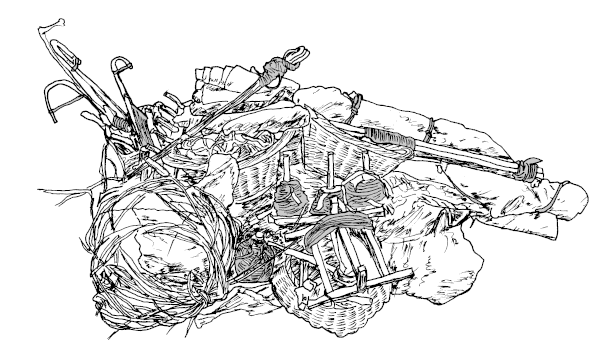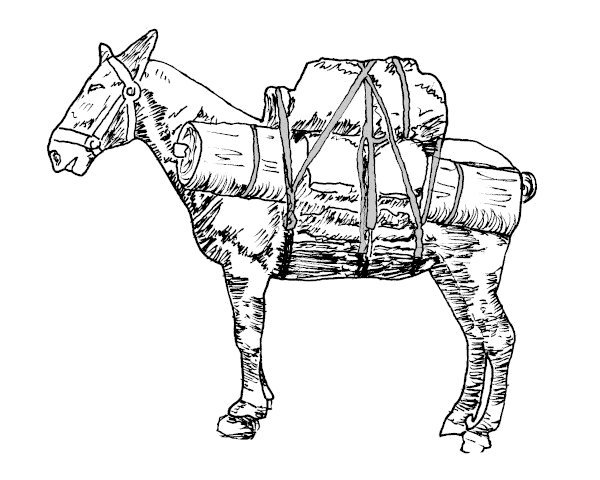Packing the (Hypothetical) Mule

Figure 1: The Problem.
The Problem
Most bulk shipping before the Revolutionary War was on the rivers, bays, and along the East Coast.
The roads in Pre-revolutionary America were few and far between. There was the King's Highway
from Charleston to Boston, and the Great Wagon Road in the Shenandoah Valley,
but not many East-West roads. Wheeled vehicles just weren't practical away from
the cities. It would commonly take two and a half weeks to go overland from New York city to Ohio.
It was easier, cheaper, and faster to ship goods in bulk from the Ohio Valley down the Ohio River to the Mississippi,
into the Gulf of Mexico, around the tip of Florida, and back up the coast to New York.
The Erie Canal, and the Chesapeake and Ohio Canal, were each started after 1800.
Away from the major freight corridors, everything moved on pack animals.
A Solution
To be clear, I don't own a mule, nor have I ever packed one. Everything I know
comes from the sources at the bottom of this page. But I figure one mule is about
all the freight haulage a rural Colonial ropemaker
could afford.
The various sources indicate one hundred fifty, to two hundred pounds is a tolerable load, and
nothing over 8 feet long. I'm aiming to keep my gear under two hundred pounds.

Figure 2: The Ideal Solution.
The Load
Here's what I've been hauling to Market Fairs and such:
| Equipment |
Length
(in.) |
Width
(in.) |
Height
(in.) |
Weight
(lbs.) |
| Bag of General Tools |
12 |
12 |
16 |
15 |
| Bag of Rope |
24 |
12 |
30 |
25 |
| Bench |
48 |
9 |
6 |
30 |
| Canopy |
90 |
8 |
8 |
20 |
| Chest of Rope Tools |
36 |
12 |
12 |
15 |
| Cooking Gear |
16 |
16 |
12 |
20 |
| Fire Tripod |
48 |
6 |
6 |
10 |
| Table |
43
72 |
14
14 |
7
7 |
20
25 |
| Tent |
72 |
9 |
9 |
20 |
| Willow Basket of Rope, Pulleys, etc. |
36 |
24 |
24 |
15 |
| Willow Basket of Raw Fibers |
36 |
24 |
24 |
5 |
| Winter Bedding |
36 |
24 |
24 |
25 |
| Total |
- |
- |
- |
245 |
So I've got some trimming to do.
- In Summer, I don't need all those wool blankets (I like to stay warm),
which will trim about twenty pounds.
- If I don't do any cooking, and just eat cold food (or buy my food from the
locals), then I don't need the cooking gear and tripod.
That saves thirty pounds.
But then I don't have a fire to make
charcord.
Under 200 pounds, split between me and the mule, my mule should be pleased.
And I may even be able to bring back something home for the family.
But still a lot of room for improvement.
Bibliography
Filson (c. 2020)
How to Pack a Mule with a Diamond Hitch & What to Bring
Accessed 04 August 2021 from
https://www.filson.com/blog/how-to/pack-a-mule-with-a-diamond-hitch-and-packing-list/
407
Headquarters, Department of the Army (June 2004)
Special Forces Use of Pack Animals
Accessed 13 March 2021 from
https://fas.org/irp/doddir/army/fm3-05-213.pdf
478
Kattell, John (2013)
Packable Trail Bridges
Accessed 13 March 2021 from
https://www.fs.fed.us/t-d/pubs/pdfpubs/pdf03713817/pdf03713817dpi72.pdf
Walley, Cherilyn A (2005)
Of Mules and Men
The 612th and 613th Field Artillery Battalions (Pack) in Burma
Accessed 04 August 2021 from
https://arsof-history.org/articles/v1n2_mules_and_men_page_1.html


